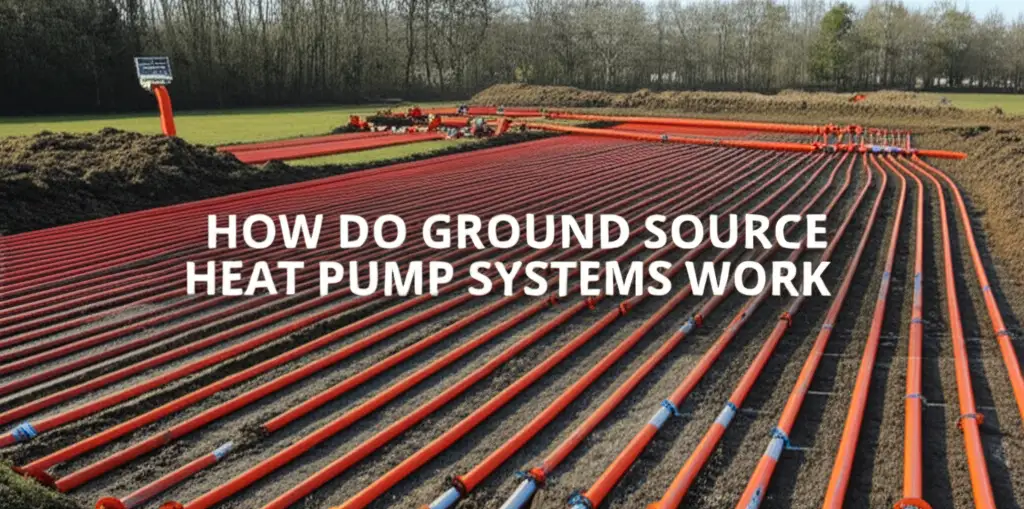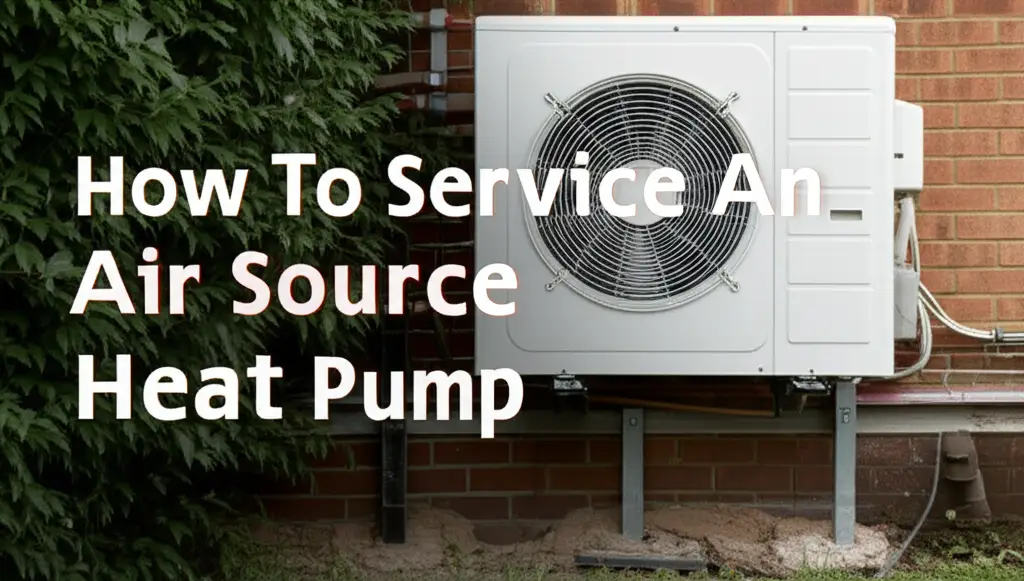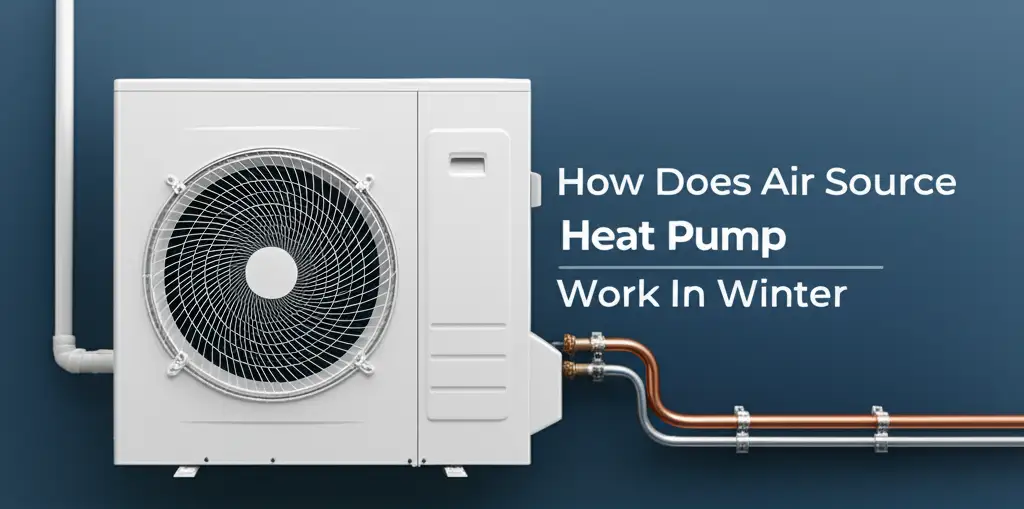· Kianna Connelly · Home Heating · 19 min read
How Do Ground Source Heat Pump Systems Work

Unlock Efficient Home Heating: How Do Ground Source Heat Pump Systems Work?
Imagine a heating and cooling system that taps into the stable temperature of the earth right beneath your feet. This is exactly how ground source heat pump systems work. These innovative systems offer a sustainable way to keep your home comfortable year-round, significantly reducing your reliance on fossil fuels. Many homeowners seek more energy-efficient solutions for their homes today. Understanding the principles behind ground source heat pump operation can help you make informed decisions about your property. This article will explain the core components, operational cycles, and various types of ground source heat pump systems. We will also explore their benefits, installation considerations, and maintenance requirements. Prepare to discover the power of geothermal energy for your home.
Takeaway
- Ground source heat pumps (GSHPs) use the earth’s stable temperature for highly efficient heating and cooling.
- GSHP systems consist of a ground loop, a heat pump unit, and a heat distribution system.
- They move heat, rather than generate it, consuming less electricity than traditional systems.
- Installation involves careful planning and significant upfront investment, but offers long-term savings.
- GSHPs provide comfort, reduce carbon footprints, and offer a sustainable energy solution.
Ground source heat pump systems work by transferring thermal energy from the earth into your home for heating, and vice-versa for cooling. They leverage the consistent temperature of the ground, which stays relatively stable throughout the year, unlike fluctuating air temperatures. This allows them to operate with remarkable efficiency, providing comfortable indoor climates using minimal electricity.
The Core Principle: Harnessing Earth’s Stable Temperature
The earth beneath our feet holds a surprisingly consistent temperature. Just a few feet down, the ground remains at a stable 45-75 degrees Fahrenheit (7-24 degrees Celsius) year-round, regardless of extreme weather above ground. Ground source heat pump systems exploit this natural stability. They do not create heat; instead, they move it. This fundamental difference makes them incredibly energy efficient.
In winter, the ground source heat pump extracts heat from the warmer earth. It then transfers this heat into your home. The process is similar to how a refrigerator removes heat from its interior. In summer, the process reverses. The system pulls heat from your home and deposits it into the cooler ground. This simple yet effective principle allows GSHPs to provide both heating and cooling from a single system. My own experience with heating has shown me that stable temperatures are key to comfort and lower bills.
This constant earth temperature is the secret to the high efficiency of these systems. Air source heat pumps face challenges in very cold weather, for instance. A ground source heat pump does not experience this drop in performance. This is because the ground temperature does not fluctuate as much. The Earth acts as a vast, natural battery, storing solar energy and maintaining a consistent thermal reservoir. Ground source heat pump systems simply tap into this readily available energy.
Key Components of a GSHP System
Understanding how a ground source heat pump system works requires knowing its main parts. These components work together seamlessly to transfer heat between your home and the earth. Each part plays a critical role in the system’s overall efficiency and performance. Familiarity with these elements helps in appreciating the system’s engineering.
First, there is the ground loop, also known as the earth loop or ground heat exchanger. This is a network of pipes buried underground. It circulates a fluid, typically water mixed with antifreeze, which absorbs or dissipates heat from or to the earth. The type and length of this loop depend on your property and heating needs. We will explore different ground loop configurations shortly.
Next is the heat pump unit itself, often located indoors. This unit contains a heat exchanger, a compressor, and a fan. It is the heart of the system. The heat pump unit processes the fluid from the ground loop. It extracts or releases heat, depending on whether heating or cooling is required. This unit then transfers the conditioned air into your home’s air distribution system.
Finally, the heat distribution system delivers the heated or cooled air throughout your living spaces. This typically involves ductwork, similar to a traditional forced-air furnace. Some systems also connect to radiant floor heating or hot water radiators. This integrated design ensures even temperature control throughout your entire home. For more on what these systems look like, you can review details on what does ground source heat pump look like. Each part is vital for the reliable operation of your ground source heat pump.
The Refrigerant Cycle Explained
The heat pump unit uses a refrigeration cycle to move heat. This cycle has four main stages:
- Evaporation: The circulating fluid from the ground loop enters the heat pump unit. It passes over an evaporator coil containing a liquid refrigerant. The refrigerant absorbs the heat from the fluid, causing it to evaporate into a gas. This gas is now warm.
- Compression: The gaseous refrigerant then goes into a compressor. The compressor increases the pressure and temperature of the gas significantly. This makes the gas very hot.
- Condensation: The hot, high-pressure gas moves to a condenser coil. Here, it releases its heat to the home’s air distribution system (for heating) or to the ground loop (for cooling). As it releases heat, the refrigerant condenses back into a liquid.
- Expansion: The liquid refrigerant passes through an expansion valve. This valve lowers its pressure and temperature, preparing it to absorb more heat in the evaporator, thus completing the cycle.
This continuous cycle allows the heat pump to efficiently transfer heat using a relatively small amount of electricity. This is why ground source heat pump systems are so effective at maintaining comfortable indoor temperatures.
Types of Ground Loop Systems Explained
The ground loop is a critical part of any ground source heat pump system. Its design determines how effectively heat is exchanged with the earth. Several types of ground loop configurations exist, each suited for different property sizes, soil conditions, and budgets. Understanding these options is key to proper system design.
Horizontal Loops
Horizontal loops are commonly used where ample land is available. Installers dig trenches, typically 4 to 6 feet deep. Plastic pipes are then laid horizontally within these trenches. This method requires a significant amount of land for installation. For example, a typical home might need several hundred feet of trenching.
- Pros: Generally less expensive to install than vertical loops. Easier to access for future maintenance.
- Cons: Requires a large land area. Can be disruptive to landscaping during installation.
- Best for: Homes with large yards, new construction sites.
Vertical Loops
Vertical loops are ideal for properties with limited land area. Installers drill boreholes deep into the ground, usually 150 to 400 feet deep. U-shaped pipes are then inserted into these boreholes. This method minimizes surface disruption.
- Pros: Requires very little yard space. Minimal impact on landscaping. Often more consistent temperature exchange at greater depths.
- Cons: Higher installation cost due to drilling. Requires specialized drilling equipment.
- Best for: Smaller lots, urban areas, existing homes with limited yard space. Questions about how deep does ground source heat pump need to be are usually answered by considering these types.
Pond/Lake Loops
If your property is near a suitable body of water, a pond or lake loop might be an option. Coils of pipe are submerged in the water body. The water acts as the heat exchange medium. This method is highly efficient due to the excellent thermal conductivity of water.
- Pros: Very efficient heat exchange. Can be cost-effective if a suitable water body is available.
- Cons: Requires access to a sufficiently large and deep pond or lake. Environmental regulations may apply.
- Best for: Properties with a private pond or lake.
Open Loops (Well Water Systems)
Open loop systems use groundwater from an existing well as the heat exchange fluid. Water is pumped from a supply well, circulated through the heat pump, and then discharged back into a separate return well or a surface water body. This is a highly efficient option due to the constant temperature of groundwater.
- Pros: Highly efficient. Requires less piping than closed-loop systems.
- Cons: Requires access to sufficient, clean groundwater. Requires a discharge method. Potential for mineral buildup in pipes.
- Best for: Properties with abundant, clean groundwater and proper discharge options.
Each ground loop type offers distinct advantages. The choice depends on your specific site conditions and budget. Consulting with a qualified installer is crucial to determine the most suitable option for your home.
The Heat Exchange Process: Heating Your Home
Understanding the exact journey heat takes through a ground source heat pump system clarifies its efficiency. The entire process hinges on the principles of heat transfer, moving warmth from one place to another. This is a continuous cycle designed to provide consistent indoor temperatures. I always explain that it’s like a sophisticated conveyor belt for heat, moving it where it’s needed.
During the heating season, the ground acts as the heat source. The fluid circulating in the buried ground loop absorbs heat from the relatively warmer earth. Even when the air above ground is freezing, the soil below retains heat. This warmed fluid then travels back to the indoor heat pump unit.
Inside the heat pump, this slightly warmed fluid passes over an evaporator coil. This coil contains a special refrigerant. The refrigerant has a very low boiling point, so it easily turns into a gas by absorbing the heat from the incoming fluid. This step captures the thermal energy from the earth. The now-chilled fluid returns to the ground loop to collect more heat.
Next, a compressor within the heat pump unit significantly increases the pressure and temperature of this gaseous refrigerant. This hot, high-pressure gas then moves to a condenser coil. Here, the heat is transferred from the hot gas to the indoor air distribution system or to water for radiant heating. As the heat is released, the refrigerant condenses back into a liquid.
Finally, the liquid refrigerant goes through an expansion valve, which reduces its pressure and temperature. This prepares it to absorb more heat from the ground loop, restarting the cycle. This continuous process of evaporation, compression, condensation, and expansion allows the ground source heat pump to efficiently extract heat from the earth and deliver it to your home. This cycle is fundamentally what makes ground source heat pump systems work so effectively, moving heat rather than generating it. The amount of electricity a ground source heat pump uses is mainly for running the compressor and pumps, not for directly creating heat. You can learn more about how much electricity does ground source heat pump use for an in-depth understanding.
Cooling Capabilities and Year-Round Comfort
Ground source heat pump systems are not just for heating; they are also highly effective at cooling your home. This dual functionality is one of their significant advantages, providing year-round comfort from a single integrated system. The ability to switch between heating and cooling modes efficiently makes them a versatile choice for many climates. I find this aspect particularly appealing for homeowners looking for comprehensive climate control.
During the summer months, the system simply reverses its operation. Instead of extracting heat from the earth, the ground source heat pump begins to transfer heat from your home to the earth. Your indoor air becomes the heat source. The heat pump extracts warmth from the indoor air and transfers it to the refrigerant. This process cools your living spaces.
The heated refrigerant then moves through the heat pump’s compressor and condenser. In cooling mode, the condenser coil releases the heat into the ground loop. The ground loop fluid absorbs this heat and carries it into the cooler earth. The earth acts as a heat sink, absorbing the unwanted heat from your home. This cycle continuously removes heat from your interior, sending it deep underground.
Some ground source heat pump systems offer a feature called “passive cooling” or “free cooling.” In this mode, the system bypasses the compressor entirely. Instead, the relatively cool fluid from the ground loop circulates directly through the indoor heat exchanger coil. This directly absorbs heat from your home’s air, dissipating it into the ground. This method uses very little electricity, only needing power for the circulating pumps. It is highly efficient for cooling when the ground temperature is sufficiently cool, which is often the case.
The ability of ground source heat pump systems to provide both heating and cooling makes them a complete climate control solution. Their efficiency in both modes, leveraging the earth’s stable temperature, contributes to lower energy bills and a smaller carbon footprint. If you are curious about specific cooling capabilities, articles like can ground source heat pump be used for cooling provide more details. This versatility makes GSHPs a smart investment for modern homes.
Installation Considerations and Site Preparation
Installing a ground source heat pump system is a significant undertaking that requires careful planning and specialized expertise. The installation process involves more than just setting up an indoor unit; it primarily focuses on preparing the ground loop, which is the most intensive part. I always advise homeowners that understanding these steps helps manage expectations and ensures a smooth project.
The first step is a thorough site assessment. A qualified installer will evaluate your property’s soil conditions, geology, available land area, and energy needs. This assessment determines the most suitable type of ground loop (horizontal, vertical, pond, or open loop) and its required size. The size of the heat pump unit itself also needs careful calculation to match your home’s heating and cooling loads. For example, knowing how to calculate ground source heat pump size is crucial for optimal performance.
Ground loop installation is the most disruptive part of the process. For horizontal loops, trenches are dug across a large section of your yard. For vertical loops, specialized drilling equipment is brought in to create deep boreholes. This part of the installation can temporarily impact your landscaping. Installers must ensure pipes are laid correctly and connections are secure to prevent leaks and ensure efficient heat transfer. The depth of the pipes is a common question; for vertical loops, [how deep do you need to drill for ground source heat pump](https://homeessentialsguide.com/how-deep do you need to drill for ground source heat pump) can be hundreds of feet.
Once the ground loop is in place and backfilled, the indoor unit installation begins. This involves connecting the ground loop to the heat pump unit. The heat pump unit is typically placed in a utility room, basement, or garage. It connects to your home’s existing ductwork or hydronic distribution system. Electrical connections and control wiring are also installed at this stage.
Finally, the system is charged and tested. The ground loop is filled with a water-antifreeze solution, purged of air, and pressure-tested for leaks. The entire system is then started up and calibrated to ensure it operates efficiently. This testing phase confirms all components are working together correctly. Understanding how much for ground source heat pump installation is important, as these initial costs are higher than traditional systems due to the groundwork. However, the long-term energy savings often justify this investment.
Efficiency, Benefits, and Environmental Impact
Ground source heat pump systems are renowned for their exceptional efficiency. Unlike furnaces that burn fuel to generate heat, GSHPs simply move existing heat, which requires much less energy. This fundamental difference leads to significant benefits for homeowners and the environment. I often tell people it’s like borrowing warmth instead of manufacturing it.
The efficiency of a GSHP system is measured by its Coefficient of Performance (COP). A COP of 4 means that for every unit of electricity consumed, the system delivers 4 units of heating or cooling energy. This translates to efficiencies ranging from 300% to 500%. For instance, a traditional furnace might be 90% efficient, meaning it wastes 10% of its fuel. A GSHP, however, produces several times more energy than it consumes, making it incredibly cost-effective over its lifespan.
Key Benefits for Homeowners
- Lower Operating Costs: Due to high efficiency, ground source heat pumps can reduce heating and cooling bills by 25-70% compared to conventional systems. This is a major factor for many people considering these systems.
- Consistent Comfort: GSHPs provide very stable indoor temperatures without the wide temperature swings often associated with other heating systems. You get consistent warmth in winter and cool air in summer.
- Long Lifespan: The indoor components of a GSHP can last 20-25 years, while the buried ground loop can last 50 years or more. This long durability means fewer replacements over time.
- Quiet Operation: Since the noisiest components (compressor and fan) are typically located indoors and insulated, GSHP systems operate very quietly. There is no outdoor unit creating noise.
- Reduced Maintenance: With fewer moving parts exposed to outdoor elements, GSHPs generally require less maintenance than air source heat pumps or traditional furnaces.
- Increased Home Value: Installing a ground source heat pump can enhance your property’s value, signaling a modern, energy-efficient home to potential buyers.
Environmental Impact
Ground source heat pumps have a significant positive impact on the environment. They dramatically reduce a home’s carbon footprint. By using the earth’s renewable energy, they decrease reliance on fossil fuels. This leads to fewer greenhouse gas emissions. For homeowners seeking to lower their environmental impact, a GSHP is an excellent choice. It is a clean, sustainable energy solution that contributes to a healthier planet. These systems represent a forward-thinking approach to home comfort and environmental stewardship.
Maintenance and Longevity of GSHP Systems
Ground source heat pump systems are known for their durability and low maintenance requirements. However, like any complex mechanical system, they do benefit from routine care. Proper maintenance ensures optimal performance, extends the system’s lifespan, and helps prevent unexpected issues. I always emphasize that a little attention goes a long way with these reliable systems.
The most critical part of a ground source heat pump system, the ground loop, is virtually maintenance-free. Buried deep underground, it is protected from weather extremes and mechanical damage. The pipes are made of durable materials that resist corrosion and degradation for decades, often lasting 50 years or more. This longevity is a major selling point.
The indoor heat pump unit, however, does require some attention. Here’s what typically goes into maintaining a GSHP system:
- Regular Filter Changes: Just like a traditional furnace, the indoor air filter needs to be checked monthly and replaced every 1-3 months. A clean filter ensures good airflow and protects the heat pump’s internal components from dust and debris. This is a simple task you can often do yourself.
- Annual Professional Check-up: Schedule a professional inspection once a year. A qualified technician will:
- Check refrigerant levels and pressures.
- Inspect electrical connections for wear or corrosion.
- Clean coils (evaporator and condenser) for optimal heat transfer.
- Verify the thermostat is working correctly.
- Check for proper operation of pumps and fans.
- Inspect ductwork for leaks.
- Test the overall system performance.
- Monitoring System Performance: Pay attention to how your system is operating. Unusual noises, reduced heating/cooling, or increased energy bills can signal an issue. Addressing problems early can prevent more significant damage. You can learn about potential issues by reviewing what can go wrong with ground source heat pump.
The indoor heat pump unit typically has a lifespan of 20-25 years. With proper maintenance, you can expect your system to perform efficiently for many years. Because ground source heat pump systems have fewer exposed components than air source heat pumps, they tend to experience less wear and tear from outdoor elements. This contributes to their robust nature and long operational life. Investing in professional maintenance ensures your ground source heat pump continues to provide reliable, energy-efficient comfort for decades.
FAQ Section
How efficient are ground source heat pumps?
Ground source heat pumps are highly efficient, typically achieving a Coefficient of Performance (COP) of 3 to 5. This means for every unit of electricity they consume, they deliver 3 to 5 units of heating or cooling energy. This efficiency significantly reduces energy consumption and operating costs compared to traditional heating and cooling systems, making them an excellent choice for long-term savings.
Can ground source heat pumps provide cooling?
Yes, ground source heat pumps are designed for both heating and cooling. In summer, the system reverses its operation, extracting heat from your home and transferring it into the cooler earth. Some systems also offer “passive cooling,” circulating cool fluid from the ground loop directly into your home, using minimal electricity.
What is the lifespan of a ground source heat pump system?
Ground source heat pump systems boast impressive longevity. The indoor heat pump unit typically lasts 20 to 25 years, comparable to or longer than traditional HVAC systems. The buried ground loop, made of durable, inert materials, can last 50 years or even more, often outliving the home it serves.
Do ground source heat pumps work in very cold climates?
Absolutely. Ground source heat pumps are exceptionally well-suited for cold climates. The earth’s temperature below ground remains stable regardless of surface air temperatures. This consistent heat source allows GSHPs to maintain high efficiency even when outdoor air temperatures drop far below freezing, unlike air source heat pumps which see performance diminish in extreme cold.
Is a ground source heat pump system noisy?
Ground source heat pump systems are known for their quiet operation. Unlike air source heat pumps that have a noisy outdoor fan unit, the main components of a GSHP are located indoors. The outdoor ground loop is completely silent. This makes them an excellent choice for homes where outdoor noise levels are a concern.
Do ground source heat pumps require a lot of land?
The amount of land needed depends on the type of ground loop. Horizontal loops require a significant amount of open land for trenches. Vertical loops, however, are ideal for smaller properties because they involve drilling deep, narrow boreholes, minimizing surface disruption. Your installer will recommend the best option for your specific site.
Conclusion
Understanding how ground source heat pump systems work reveals a world of efficient, sustainable home comfort. These remarkable systems harness the earth’s stable temperature, providing consistent heating and cooling with minimal electricity consumption. From the buried ground loops extracting heat to the indoor unit distributing it, every component plays a vital role in their exceptional performance. I believe this technology represents a smart investment for the future of your home.
The benefits extend far beyond just energy savings, encompassing enhanced indoor comfort, quiet operation, and a significantly reduced carbon footprint. While the initial investment for a ground source heat pump can be higher than conventional systems, the long-term operational savings and extended lifespan offer compelling value. These systems prove that advanced climate control can coexist with environmental responsibility.
If you are considering a future-proof, eco-friendly, and cost-effective solution for your home’s heating and cooling needs, exploring a ground source heat pump system is a decision you won’t regret. Consult with a qualified professional today to see how this incredible technology can transform your home’s energy profile.





